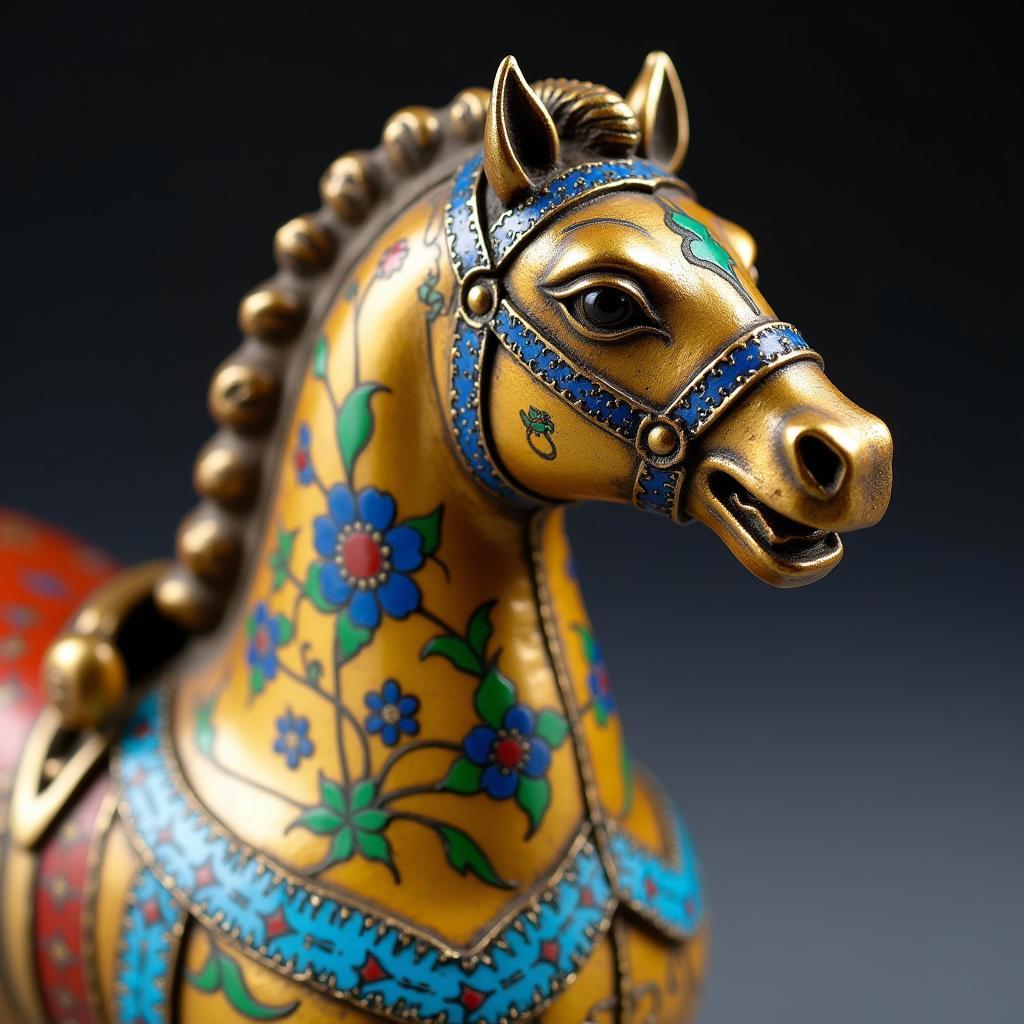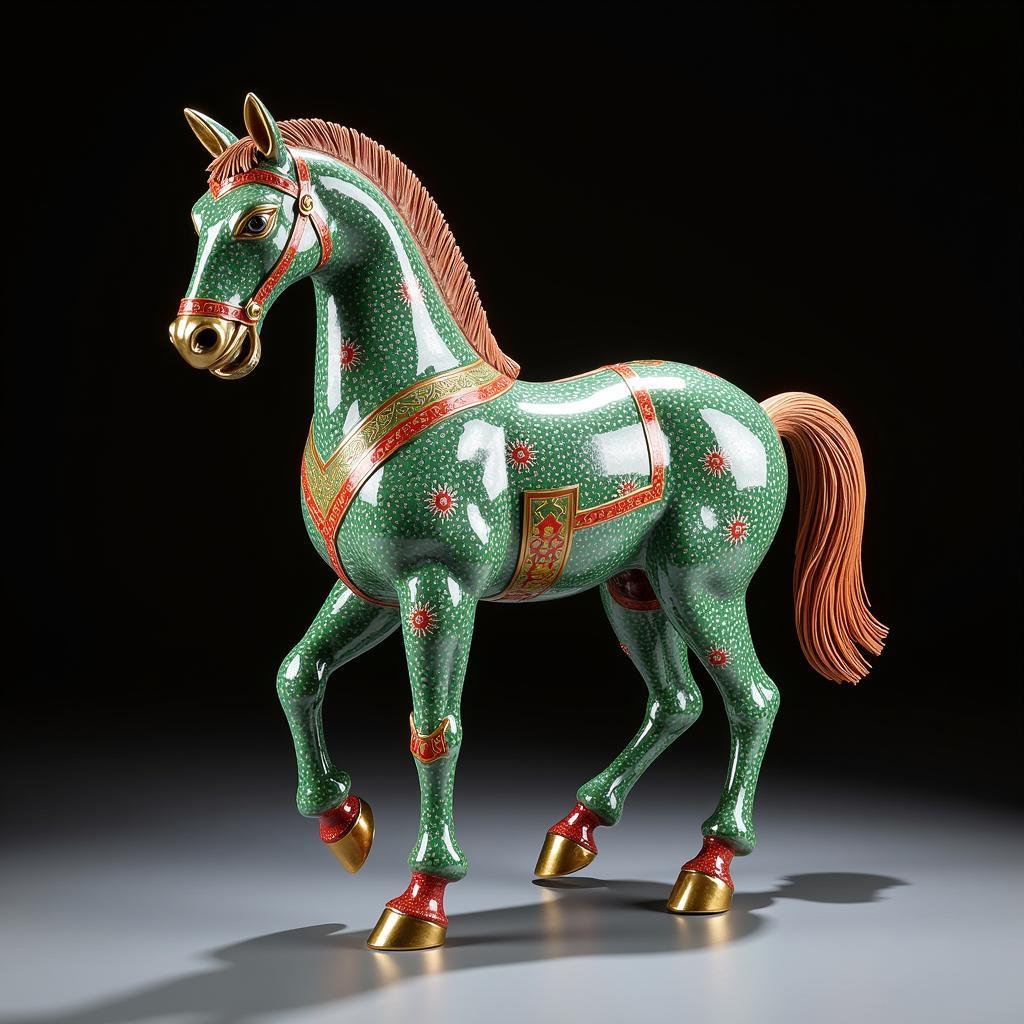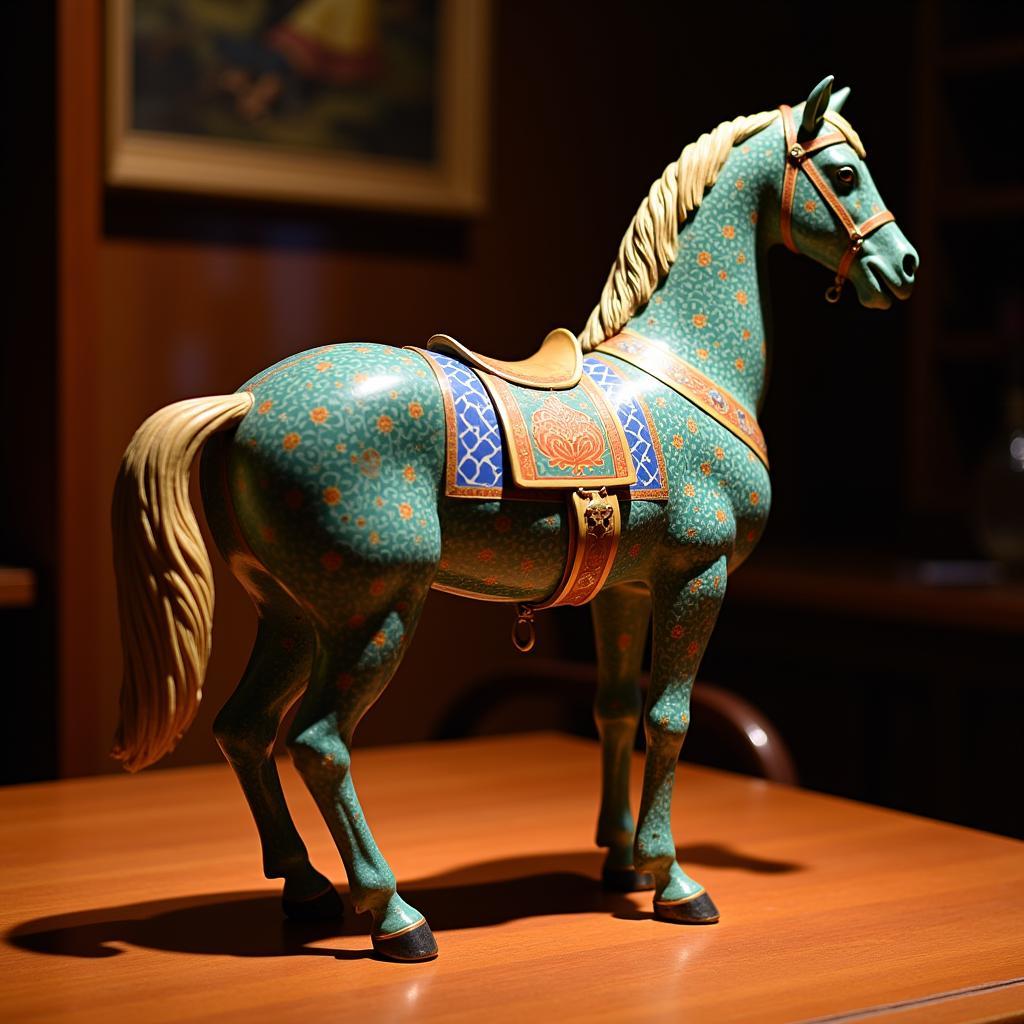Cloisonne Horses, with their exquisite enamel work and intricate designs, are more than just decorative objects; they are miniature masterpieces that embody artistry and cultural significance. The technique, originating centuries ago, involves meticulously shaping thin wires of gold, silver, or copper onto a metal base to create intricate compartments, or cloisons. These compartments are then painstakingly filled with vibrantly colored enamel paste, each shade meticulously chosen to bring the design to life. After multiple firings and polishings, the result is a stunning piece with a smooth, jewel-like surface that seems to shimmer with an inner light.
A Journey Through Time and Culture: The History of Cloisonne Horses
 Ancient Chinese Cloisonne Horse Figurine
Ancient Chinese Cloisonne Horse Figurine
The history of cloisonne, known as “Jingtailan” in Chinese, can be traced back to the Byzantine Empire, eventually finding its way to China during the Yuan dynasty (1271-1368). However, it was during the Ming dynasty (1368-1644) that cloisonne truly flourished, reaching its zenith under the reign of the Jingtai Emperor (1449-1457). During this period, the distinctive blue enamel, now often associated with cloisonne, became particularly prized.
Cloisonne horses, along with other animal figures and intricate vessels, became highly sought-after treasures, gracing the palaces of emperors and the homes of the elite. These pieces were not merely decorative but often held symbolic meaning. The horse, in Chinese culture, represents strength, speed, and perseverance. It is associated with nobility, military prowess, and success in life. Therefore, gifting a cloisonne horse conveyed wishes for prosperity, good fortune, and a smooth journey through life.
The Enduring Allure of Cloisonne Horses
 Contemporary Cloisonne Horse Sculpture
Contemporary Cloisonne Horse Sculpture
Today, cloisonne horses continue to captivate art enthusiasts and collectors worldwide. Their timeless elegance transcends fleeting trends, making them cherished additions to homes, museums, and private collections. While antique cloisonne pieces are highly valued, contemporary artists continue to push the boundaries of this ancient art form. They experiment with new designs, colors, and techniques, breathing fresh life into this ancient tradition while honoring its rich heritage.
Caring for Your Cloisonne Horse: Tips for Preservation
Cloisonne, despite its delicate appearance, is relatively durable. However, proper care ensures that your cloisonne horse retains its vibrancy and beauty for generations to come:
- Handle with Care: While cloisonne enamel is hard, it can chip or crack upon impact. Always handle your cloisonne horse with clean hands, lifting it from the base, not the delicate wirework.
- Dust Gently: Regularly dust your cloisonne horse with a soft, dry cloth. Avoid using abrasive cleaners or harsh chemicals, as they can damage the enamel.
- Avoid Extreme Temperatures: Sudden changes in temperature or prolonged exposure to direct sunlight can cause the enamel to crack.
- Display Thoughtfully: Choose a stable surface away from direct sunlight or heat sources. Consider displaying your cloisonne horse in a glass case to provide an extra layer of protection.
Beyond Aesthetics: The Investment Value of Cloisonne Horses
 Antique Cloisonne Horse at Auction
Antique Cloisonne Horse at Auction
Besides their aesthetic appeal, cloisonne horses can be sound investments. Antique pieces, particularly those from the Ming and Qing dynasties, are highly sought after by collectors, often fetching high prices at auctions. The value of a cloisonne horse is determined by factors like age, condition, rarity, craftsmanship, and historical significance.
Expert Insight: “When considering a cloisonne horse as an investment,” advises Dr. Emily Carter, a renowned Asian art historian, “it is essential to purchase from reputable sources. Look for pieces with clear provenance, expert authentication, and documentation. “
Exploring the World of Cloisonne Horses
The world of cloisonne horses offers a fascinating blend of art, history, and culture. Whether you’re drawn to their vibrant colors, intricate designs, or historical significance, these miniature masterpieces offer a glimpse into a rich and enduring artistic tradition.
By understanding the history, craftsmanship, and care tips, you can appreciate the artistry of these exquisite pieces and ensure their beauty endures for years to come.
FAQs about Cloisonne Horses
1. How can I tell if a cloisonne horse is antique or a modern reproduction?
Answer: Look for signs of age like patina, wear on the base, and slight imperfections in the enamel. However, it’s always best to consult with an expert for authentication.
2. Can cloisonne horses be repaired if damaged?
Answer: Yes, skilled artisans specializing in cloisonne restoration can repair chips, cracks, or missing enamel.
3. Where can I find reputable sellers of cloisonne horses?
Answer: Reputable antique shops, auction houses, and specialized online galleries are good places to start.
4. Are there different sizes of cloisonne horses?
Answer: Yes, cloisonne horses are created in a variety of sizes, from miniature figurines to larger, more impressive sculptures.
5. Do the colors in cloisonne have specific meanings?
Answer: Yes, in Chinese culture, colors often hold symbolic meanings. For example, red represents good fortune, yellow is associated with royalty, and green symbolizes growth and prosperity.
Need Help? Contact Justus Horses USA
For any assistance related to horses and pets, please reach out to us.
Phone Number: 0772127271
Email: [email protected]
Address: QGM2+WX2, Vị Trung, Vị Thuỷ, Hậu Giang, Vietnam
Our customer service team is available 24/7 to answer your queries.